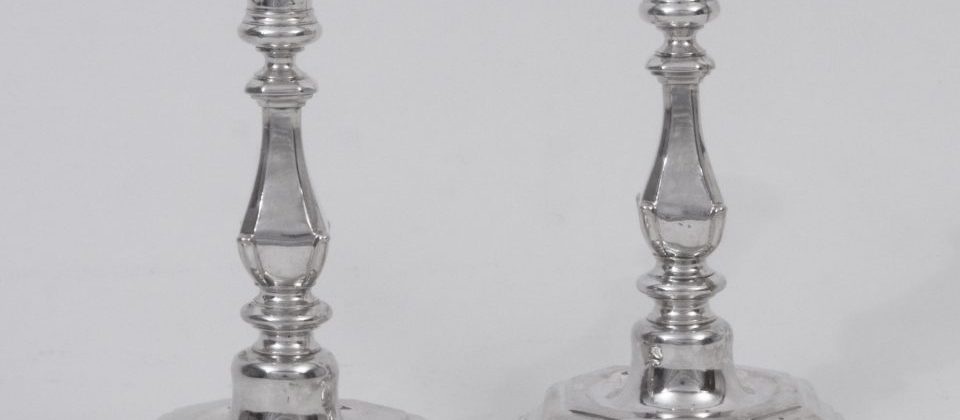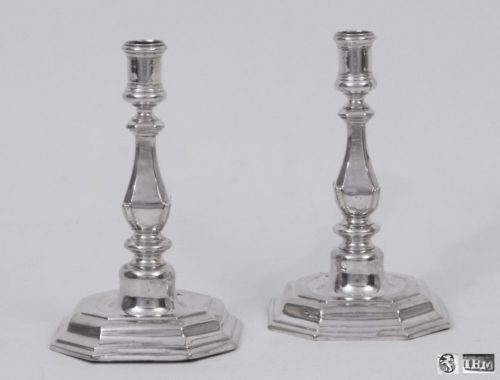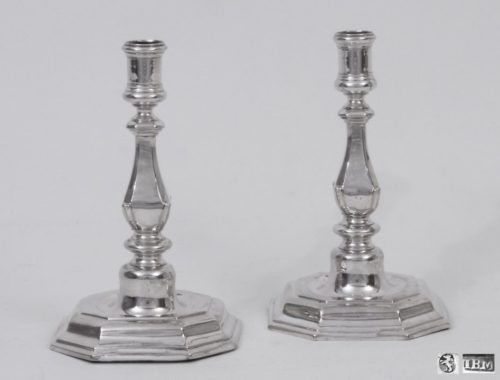Object Number: #711
Berlin, ca. 1740/50
Maker: Johann Bernhardt Müller
City’s hallmark: a standing bear in a circle for Berlin, for objects with 12parts silver finesse, period 1740-1750 (Scheffler 1968 no 4b; Rosenberg3 no 1149).
Maker’s mark: monogram “IBM” in a rectangle for Johann Bernhardt Müller (Scheffler 1968 no 599/127; s. also Scheffler 1968 no 600 A/1st row, (e)).
Height: 18 cm (7,08 in.); weight: each 220 gr.
Detailed Information
A Pair of Berlin Silver Candlesticks
This pair of candlesticks presents a baluster formed type of silverware candlesticks from Berlin. The octagonal, edged foot is vaulted and bright as well as decorated in different levels. A shaft with a baluster form rises above it. Above a node is standing the central part of the shaft, which is decorated with squares. A smaller node connects the shaft with the vase- and baluster-shaped spout, which is also decorated with profiled rings. The décor motive that is formed from round forms gives the impression of harmonic volumes.
Silver and Porcelain Forms in Berlin Works
Scheffler publishes in his book on goldsmiths of Berlin not only this candlestick, but also a similar type of table candlesticks made of porcelain, which has been produced in the Royal Porcelain Manufacture in Berlin around 1785 (cf. Scheffler 1968: fig. 66 and 67). This indicates that this form of candlesticks was popular and successful during the last quarter of 18th century as well.
Silver like porcelain belonged to the sumptuous equipment of castles in Berlin. Due to the turbulent history of the city, many objects from these places have been destroyed. However, religious devices and silverware of noble and bourgeois possession permits to admire and respect until today the sure, highly qualitative and well executed Berlin works from silver and gold.
Maker
Johann Bernhard Müller is born as the son of a soldier. Around 1737, he became head master and on the 1st March 1737 he took the citizen’s oath as a goldsmith. He got married to Anna Sabina (Sophia) Ebel. On the 14th June 1762, he took the second drawing-master’s oath. On the 2nd May 1777, he is mentioned as warden at the Assay Office of Potsdam. He died before 1784.
Johann Bernhard Müller had a brother, Martin Friedrich Müller (ca. 1706-1780), who took the citizen’s oath as a goldsmith on the same day and year as his brother (s. Scheffler 1968: no 600). The sons of both masters have obviously worked as well as gold- and silversmiths. Many delivered works from that period have been often attributed to Johann Bernhard or Martin Friedrich (s. Scheffler 1968: no 600 A).
Candlesticks as well as beakers with inset coins and many other silverware from the hands of Johann Bernard Müller are to be found today in private and public collections.
Literature
Scheffler, W., 1968, Berliner Goldschmiede: Daten – Werke – Zeichen, Berlin: Verlag Bruno Hessling




